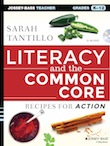12 Ways to Get Students Speaking & Listening

(Updated 6/28/22)
“Of all the ways you can improve learning in your school, the Number 1 way is to strengthen students’ speaking and listening skills and habits.”
I hope this and other observations I made in last week’s MiddleWeb post, “Unlock Student Learning by Improving Oral Fluency,” convinced teachers across the curriculum that they can significantly boost the performance of all students – and in particular, the shy non-participators – by pursuing a deliberate strategy to develop the habits of speaking and listening that most contribute to learning.
Here, without further ado, are a dozen things you can do to improve engagement and strengthen these skills. (If you read Part 1, you’ve already seen the first one.)
1. Use Think-Pair-Share + cold-calling as often as possible.
For example: “Take ___ seconds (or minutes) to jot down your thoughts about ____. [Wait the allotted time.] Now, take one minute to tell your partner what you thought. Then look at me when you’re both ready to share with the class.”
Use popsicle sticks to cold-call, to ensure that you’ll call on everyone eventually. Make it clear to students that you expect everyone to have something to say because they’ve all just written and talked about their ideas.

Having to report on their partners’ ideas compels students to listen more carefully. It also gives them valuable practice in paraphrasing and summarizing. Note: the first few times you do this, be sure to warn them so that they are prepared.
2. Encourage students to restate or paraphrase – not repeat – what their peers say.

When teaching students the value of paraphrasing — a vital conversational skill as well as a key critical reading skill – you might try the approach that Heather Lattimer describes in Thinking Through Genre. Her colleague asks students to talk about how they responded to an excerpt from Bad Boy by Walter Dean Myers.
Each time the first few students answer, Lattimer’s friend ignores what they say and instead tells her own reaction. The students become uneasy and reluctant to volunteer their thoughts. Then she calls on another student and paraphrases what he said before giving her own ideas. The students are surprised (and, quite frankly, relieved). Then she debriefs with the students on the different ways she conversed with students. They get the point: paraphrasing is a way to show that you are listening to the other person.
3. Move from paraphrasing to inference as much as you can, and ask students for evidence to back up their ideas or arguments.

Also, clarify the difference between argument and evidence. No matter what grade or subject you teach, even if the terms are not new to them, the review will establish a common language in the room. Posters can serve as handy reminders. The more students are invited to explain their ideas, the stronger their inference and comprehension skills will become.
4. Treat students as sleuths out to solve a mystery.
Tell them that they are the Detectives, and you are the Clue-Provider. My high school Latin teacher was a master at this. He knew that if we had to figure things out, we would not only remember them but also be able to explain them. In his class, in order to catch all of the clues, we had to listen very carefully.
5. Ask why as often as possible, to give students more opportunities to explain their ideas.

Note: The first few times you ask why, students who aren’t accustomed to being questioned might back away from their response or become defensive. I like to tell students, “I’m not asking why because I think you’re wrong; I’m asking why because I genuinely want to know how you think and because your explanation will help your classmates understand this better.”
6. Require students to respond with complete sentences.
This practice will enhance their fluency and comprehension. Explain why you have this expectation (which is for their benefit) to make it the norm in your class. Initially you might have to correct them a few times and model it or provide sentence starters, but students will quickly get the hang of it. I’ve taught sample lessons in classrooms where I made it the norm within five minutes. Set high standards for discourse in your room, and students will meet or exceed them.
7. Don’t repeat what students say.
Students are like cats who want more food in their bowl: they train us! If you allow students to train you to repeat what they say, then they won’t develop proper speaking or listening skills. When you repeat what students say, it sends the message that they should not to listen to one another. It also teaches them to mumble because they know you will amplify everything.

8. Use think-alouds to model how you think, including the questions you ask and the way you figure things out.
Then you can invite students to pair up and practice their own think-alouds. Making thinking visible in this way makes it more accessible for everyone, especially those students who might otherwise believe that “some people just ‘get it,’ and some people don’t.” They will see that in fact reading and thinking require work. Good readers wrestle with the text.
9. Invite students to ask questions as often as possible.

10. When reading aloud, require students to listen with a purpose or question in mind.
Reading aloud mindlessly is boring. It’s an invitation to daydreaming at best and disruptive behavior at worst. But you can’t blame the students; if you fail to engage them, they will find something to do. Spare yourself the agony by hooking them with a great question. For instance, invite them to make predictions based on evidence from the text so far. Then: “OK, let’s see who’s right!” and read the next bit. You build listening skills when they have a purpose for listening.
11. When lecturing or presenting new material, provide guided notes to keep students engaged.
In addition to keeping students actively involved, guided notes provide models of good note taking, another important skill. They also ensure that everyone walks away with the same basic information and a review sheet for later reference.

It’s highly probable that if one student mispronounces a word, others in the room would make the same mistake. In fact, if you correct this one person and move on, chances are good that the word will pop up again and someone else will stumble over it. So, it’s better to spare this first reader the embarrassment and instead send a positive message to the whole class, which is this: “This is an important word, and we all need to know how to pronounce it. So let’s go.”

Sarah consults with schools on literacy instruction, curriculum development, data-driven instruction, and school culture-building. Sarah has taught secondary English and Humanities in both suburban and urban public schools, including the high-performing North Star Academy Charter School of Newark.For more information, check out her website The Literacy Cookbook and her TLC Blog.































Many good suggestions that work on this list. I would add that having students practice the technique (paraphrasing, turn ‘n talk, etc.) using non-academic topics. For example: “turn and talk to your neighbor- tell him what your favorite ice cream is and where he/she goes to get it.”
It is worth the time to plan for practice and a good way to warm-up for the “real” questions.
Should we mention that it is important to specifically teach students HOW to speak well? We make comments as kids speak but we don’t have lessons before they speak. A lesson on descriptive hand gestures? emphatic hand gestures? body gestures? facial gestures? Never see them, yet we score gestures on our rubrics. Unfair. Find out more here: http://www.pvlegs.com
I would add engaging students in student to student discourse as part of science instruction.. Students listen to each other, ask each other questions and probe each other’s thinking. Students argue from evidence while constructing plantations about a phenomena or problem.
These are excellent suggestions for engaging students in listening and speaking skills. I am a fan of number 4, the sleuthing technique. This is something I believe would engage all my students. My students become frustrated with me when I correct their speech in class, correcting verb tenses, the misuse of I and me, among countless other mistakes they make. I also believe modeling listening and speaking skills are important as well. We can not just talk about our students using listening and speaking skills in class if we, as teachers are not willing to do the same.
Mine is a boy (8 years old) of monosyllables. He gives yes or no answers or one word answers. I am sure his teachers are doing a good job but they can’t have enough time. Not everybody speaks English in our country but the language of instruction is English. I have made it a point to talk to him in English to help him improve speaking and listening.
One of the tools I use is paraphrasing which is asking him to tell me what I just said in his own language. I also ask him to describe pictures in a story book and answer why questions. Recently I learnt to my chagrin, that he has studied many fast paced rap songs from Tic Toc which I banned until I will learn about pros and cons. I have also realized the effort has made fruits, as he loves to make and makes presentations from school lessons. I like the suggestions and will make some of them part of my tool kit.